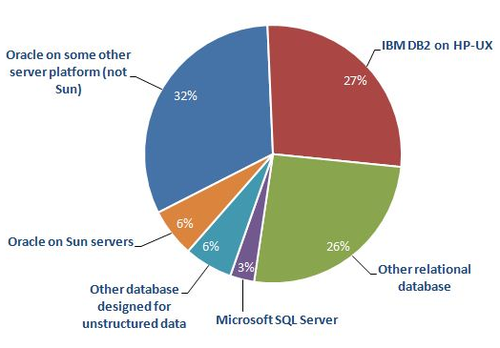Opposition HP and Oracle. Conclusion
 As I promised, I am writing the third part of the previous two posts, “How will the opposition between HP and Oracle affect open source?” And “The opposition between HP and Oracle. Continuation . Some delay turned out, because only now appeared at least some official information related to the prospects for Itanium .
As I promised, I am writing the third part of the previous two posts, “How will the opposition between HP and Oracle affect open source?” And “The opposition between HP and Oracle. Continuation . Some delay turned out, because only now appeared at least some official information related to the prospects for Itanium .Unfortunately, this information is not too joyful. It became clear that Itanium, nevertheless, slowly but surely, will leave the server market. Having lost the "software" part, represented by Oracle, the fate of Itanium was predetermined. There is no panic among customers, but I think everyone understands that in the long run, they will have to leave the platform. However, the situation is not catastrophic, companies will be able to use their Itanium servers for a long time, and most likely, most HP customers will use them as long as possible.
Where to go?
I have no doubt that according to the Oracle plan, most of the customers should switch from HP-UX / Itanium to Solaris / SPARC, following the Oracle software. But this is unlikely to happen. I will explain why.
')
The main part of large companies switched to Itanium from RISC servers and “vertical stacks” of various manufacturers. They were already in a situation when all the hardware, all the software and services are provided by one manufacturer. They switched to Itanium as “the standard architecture of heavy servers”, trying to get away from vendor lock-in, because in the early 2000s, almost all manufacturers planned to build servers on Itanum. Unfortunately, in recent years, the number of suppliers of Itanium-servers has declined dramatically, and HP has become dominant in this market, occupying it by almost 95%.
Oracle now calls them back to the 80s, telling
According to one of the polls, HP-UX administrators as an alternative to Oracle database on Itanium consider the following options:

Please note that only 6% of respondents are ready to switch to Sun iron . If you add to the performance of x86 processors the appearance of new fault tolerance and reluctance to return to the “single stack”, then it will become obvious that former Itanium users will focus on x86 servers, and not on SPARC or IBM POWER.
And what about the software?
The closest "in spirit" OS to HP-UX is Linux. Well, transferring applications from HP-UX to Windows is somehow not very easy - in fact, they need to be rewritten again. Thus, in the medium term, we should expect the transfer of applications from HP-UX to Linux, and the “retraining” of HP-UX system administrators.
Again, in terms of options, Linux runs on a variety of iron platforms, including Itanium. Well, the price factor also matters - when you have the opportunity to reduce expenses on the OS to zero, this is a good argument for the IT director in our financially hectic time.
Now let's see what options the core HP-UX / Itanium users have. As I already wrote , they can be divided into three groups:
1) SAP users
With these, the easiest thing is, they asked for an “oracle-less” solution and it will almost certainly appear, because SAP now has Sybase ASE and a desire to take second place in the DBMS market (!!!) Most likely, SAP users will not want to invest in a purchase The new hardware will therefore remain on the existing HP hardware, and in SAP they will do everything possible to keep customers from switching to the hardware of their ERP competitor.
2) Oracle users
If the users are not only DBMSs from Oracle, then most likely they will go to x86 servers, perhaps they will even be x86 servers from Sun / Oracle. But not SPARS. Not everyone has recovered from the transition to Itanium, so the transition to SPARC is unlikely. By the way, according to the latest financial reports of Oracle, revenues from the sale of equipment continue to decline .
3) software from independent developers
Independent software vendors for HP-UX / Itanium will support existing solutions as long as possible, but together with transferring software to Linux and replacing, if possible, any components with Open Source counterparts.
As a result.
In my very first post from this series of articles, a certain s0rr0w asked in the comments:
And what have OpenSource to do with it, I didn’t understand ... Two corporations decided to pull each other's forelocks. Eka nevidal! What does software have with open source?The answer is, what does the open source software have to do with it? As a result of the fact that “the two corporations decided to twitch each other's bows,” two companies that are directly connected with Open Source are clearly winning. The first is Red Hat , as the leader of corporate linux for x86 servers. Most HP-UX users will consider migrating to Linux. The number of companies transferring their software to Linux from OpenVMS, HP-UX and NonStop OS will increase, respectively, the number of companies using Linux will increase. And the second is EnterpriseDB, which is behind the development of PostgreSQL, which has a compatibility layer with Oracle DBMS and recently announced support for HP-UX / Itanium .
Source: https://habr.com/ru/post/134849/
All Articles